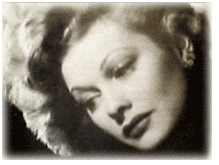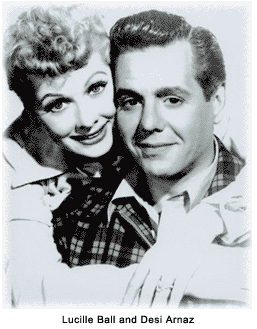Lucille Ball was an American comedienne and actress with flaming red hair. She was known during the 1930s and 1940s as the “Queen of the `B` movies.” She was far better known for her starring role with her husband Desi Arnaz in the sitcom, I Love Lucy. She became one of the most well-known and loved entertainers of all time.
 Beginnings
Lucille Désirée Ball was born as a brunette on August 6, 1911, in Celoron, New York, to Henry Durrell Ball and Desiree "DeDe" Eve Hunt. Her father was a telephone lineman for the Bell Company, and by the time Lucy was three years old, they had moved several times. When her mother was pregnant with their second child, her father contracted typhoid fever and died in 1915.
Following her father’s death, Lucy, her little brother Fredrick, and her mother moved back to Celoron to live with the maternal grandparents. Her grandfather, Fred Hunt, enjoyed Vaudeville, and encouraged Lucy to take part in school plays. Lucy dropped out of high school when she was 15. In 1925, she enrolled in the John Murray Anderson School for the Dramatic Arts, with her mother`s approval. However, she was told by the drama coaches that she "had no future at all as a performer."
First stab at fame
Lucille Ball moved to New York City to become an actress, and found some work as a fashion model for designer Hattie Carnegie, and then as a Chesterfield (cigarette) girl. Ball began her career on Broadway, using the stage name, “Dianne Belmont.” In 1933, Ball found herself in Hollywood, appearing as one of 12 slave girls in the Eddie Cantor film, Roman Scandals.
{Why was she fired? If you can`t find out, get rid of the sentence. Removed the sentenc.}
Ball signed a contract with RKO Studios and appeared in several small roles, including Top Hat in 1935. She received numerous starring roles in `B` movies and the occasional `A` film, including Stage Door in 1937. In the early 1940s, Ball signed with MGM, which landed her better roles, including, Du Barry Was a Lady in 1943, Best Foot Forward, also in 1943, and Without Love, which starred Katharine Hepburn and Spencer Tracy in 1945.
In 1940, while filming Too Many Girls, Ball met and fell in love with Desi Arnaz, a Cuban actor and musician. Following a passionate romance, they eloped in November 1940. In 1942, Arnaz was drafted into the Army. He was classified for limited service owing to a knee injury, which allowed him to stay in Los Angeles. He organized and performed USO shows for wounded GIs returning from the war. Because of an extra-marital affair Arnaz had gotten into, Ball filed for a divorce in 1944; however, the couple reconciled.
I Love Lucy
In 1948, Ball was cast as a zany wife in the CBS radio show, My Favorite Husband. The show ran for two years and was a huge success, so much so, that CBS asked her to help develop it for television. Ball agreed, but insisted on working with her husband. The show was called I Love Lucy and was produced by the couple`s Desilu company, which was established in 1951.
Ball gave birth to the couple`s first child, Lucie Desiree Arnaz, on July 17, 1951, just a month shy of her 40th birthday. She had suffered several miscarriages prior to the joyous day.
With I Love Lucy in full swing, Ball`s second pregnancy was written into the script. The network was not ready to “show a pregnant woman on television.” After much negotiation, the couple and the networked compromised and used the pregnancy in the script; however, the word “pregnant” was replaced with “expecting.” When Lucy gave birth to their son, Desiderio Albert Arnaz IV, in January 1953, it was a first for television, and the birth made the cover of of TV Guide`s first issue.
Beginnings
Lucille Désirée Ball was born as a brunette on August 6, 1911, in Celoron, New York, to Henry Durrell Ball and Desiree "DeDe" Eve Hunt. Her father was a telephone lineman for the Bell Company, and by the time Lucy was three years old, they had moved several times. When her mother was pregnant with their second child, her father contracted typhoid fever and died in 1915.
Following her father’s death, Lucy, her little brother Fredrick, and her mother moved back to Celoron to live with the maternal grandparents. Her grandfather, Fred Hunt, enjoyed Vaudeville, and encouraged Lucy to take part in school plays. Lucy dropped out of high school when she was 15. In 1925, she enrolled in the John Murray Anderson School for the Dramatic Arts, with her mother`s approval. However, she was told by the drama coaches that she "had no future at all as a performer."
First stab at fame
Lucille Ball moved to New York City to become an actress, and found some work as a fashion model for designer Hattie Carnegie, and then as a Chesterfield (cigarette) girl. Ball began her career on Broadway, using the stage name, “Dianne Belmont.” In 1933, Ball found herself in Hollywood, appearing as one of 12 slave girls in the Eddie Cantor film, Roman Scandals.
{Why was she fired? If you can`t find out, get rid of the sentence. Removed the sentenc.}
Ball signed a contract with RKO Studios and appeared in several small roles, including Top Hat in 1935. She received numerous starring roles in `B` movies and the occasional `A` film, including Stage Door in 1937. In the early 1940s, Ball signed with MGM, which landed her better roles, including, Du Barry Was a Lady in 1943, Best Foot Forward, also in 1943, and Without Love, which starred Katharine Hepburn and Spencer Tracy in 1945.
In 1940, while filming Too Many Girls, Ball met and fell in love with Desi Arnaz, a Cuban actor and musician. Following a passionate romance, they eloped in November 1940. In 1942, Arnaz was drafted into the Army. He was classified for limited service owing to a knee injury, which allowed him to stay in Los Angeles. He organized and performed USO shows for wounded GIs returning from the war. Because of an extra-marital affair Arnaz had gotten into, Ball filed for a divorce in 1944; however, the couple reconciled.
I Love Lucy
In 1948, Ball was cast as a zany wife in the CBS radio show, My Favorite Husband. The show ran for two years and was a huge success, so much so, that CBS asked her to help develop it for television. Ball agreed, but insisted on working with her husband. The show was called I Love Lucy and was produced by the couple`s Desilu company, which was established in 1951.
Ball gave birth to the couple`s first child, Lucie Desiree Arnaz, on July 17, 1951, just a month shy of her 40th birthday. She had suffered several miscarriages prior to the joyous day.
With I Love Lucy in full swing, Ball`s second pregnancy was written into the script. The network was not ready to “show a pregnant woman on television.” After much negotiation, the couple and the networked compromised and used the pregnancy in the script; however, the word “pregnant” was replaced with “expecting.” When Lucy gave birth to their son, Desiderio Albert Arnaz IV, in January 1953, it was a first for television, and the birth made the cover of of TV Guide`s first issue.
 I Love Lucy ran for 10 years, and was one of the greatest weekly shows to grace the little screen. However, when the pressure of the production and public life became too much for the couple, they canceled the show and were subsequently divorced in May 1960. Shortly following the divorce, Ball bought out Desi’s share of Desilu and became the company president. That made her the first woman to become president of a production company. Desi and Lucy remained friends until his death in 1986.
Moving on
In 1961, Ball married comedian Gary Morton; the couple remained married until her death in 1989. Following I Love Lucy, she made a few more movies, including Yours, Mine and Ours with Henry Fonda in 1968, and Mame in 1974.
However, Ball`s true home was on the small screen, where audiences loved her the most. She produced two more successful sitcoms. From 1962 to 1968, she starred in The Lucy Show with her friend and past co-star, Vivian Vance. Carol Burnett and Ball were good friends; Burnett appeared on The Lucy Show several times. Here’s Lucy, which featured Ball`s real-life children, Lucie and Desi Jr., ran from 1968 to 1974.
Ball attempted to revive her television career during the 1980s with a dramatic television movie, Stone Pillow, in 1985, which was well received. However, her 1986 Life With Lucy was a flop and was canceled less than two months into its run. That pitched her into a deep depression, and, other than a few public appearnces, she dropped out of the public eye.
I Love Lucy ran for 10 years, and was one of the greatest weekly shows to grace the little screen. However, when the pressure of the production and public life became too much for the couple, they canceled the show and were subsequently divorced in May 1960. Shortly following the divorce, Ball bought out Desi’s share of Desilu and became the company president. That made her the first woman to become president of a production company. Desi and Lucy remained friends until his death in 1986.
Moving on
In 1961, Ball married comedian Gary Morton; the couple remained married until her death in 1989. Following I Love Lucy, she made a few more movies, including Yours, Mine and Ours with Henry Fonda in 1968, and Mame in 1974.
However, Ball`s true home was on the small screen, where audiences loved her the most. She produced two more successful sitcoms. From 1962 to 1968, she starred in The Lucy Show with her friend and past co-star, Vivian Vance. Carol Burnett and Ball were good friends; Burnett appeared on The Lucy Show several times. Here’s Lucy, which featured Ball`s real-life children, Lucie and Desi Jr., ran from 1968 to 1974.
Ball attempted to revive her television career during the 1980s with a dramatic television movie, Stone Pillow, in 1985, which was well received. However, her 1986 Life With Lucy was a flop and was canceled less than two months into its run. That pitched her into a deep depression, and, other than a few public appearnces, she dropped out of the public eye.
A star with flaming red hair is snuffed out
Lucille Ball died on April 26, 1989, of a ruptured aorta at the age of 77. Her remains were originally interred in the Forest Lawn - Hollywood Hills Cemetery in Los Angeles, California, but her children later moved them to the Lake View Cemetery, in Jamestown, New York. The consummate comedienne was inducted into the National Women`s Hall of Fame in 2002.